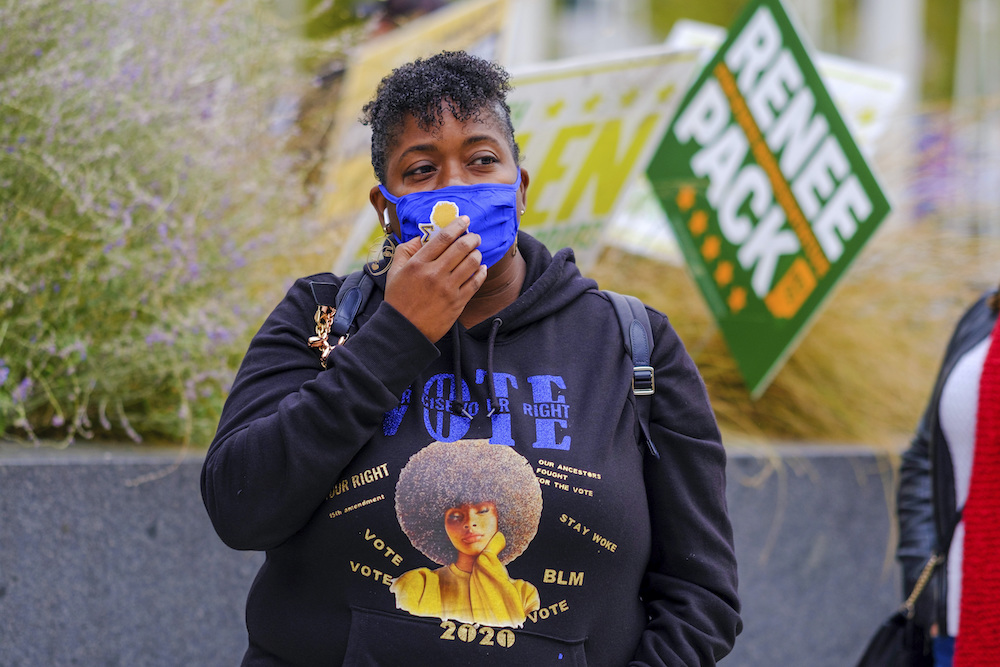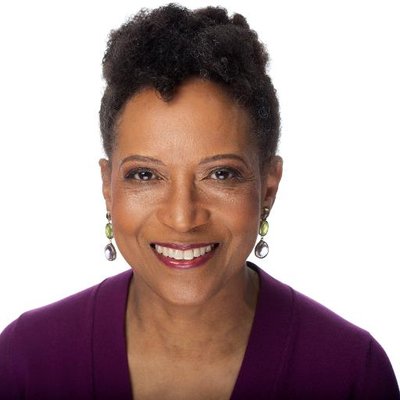
A voter wearing a facemask is seen in a line for early voting at the City-County building in Indianapolis, Indiana in October
Though I’ve seen the way the media portray Black women evolve over time, I don’t think I’ve ever seen it done exactly right — or at least with the complexity and nuance we deserve. I say we intentionally, though journalists are not supposed to be part of the story. But seeing — and not seeing — myself in the newspapers my family read and the television news shows we watched was what spurred me to choose the profession.
Or, maybe it was the reason the profession chose me.
Now, with Black women rising in visibility in fields from culture to politics, journalists are being tested in reporting on a group of Americans who have been, at turns, ignored and stereotyped. I have viewed the situation from the inside and outside.
I quickly realized when I entered the business that every journalist wears his or her or their background into every newsroom or Page 1 meeting or press conference. It’s just that only some of us get called on it and judged because of it. Whatever my job title was, representing people who looked like me in a room of people who rarely did was an unstated part of my portfolio.
The newspapers in the Baltimore of my childhood reflected all the stereotypes and misconceptions the city’s mix of racial, religious, and ethnic groups held about one another. My neighborhood of West Baltimore was a shorthand many, even those outside the city’s boundaries, may recognize. But Baltimoreans could always slice and dice areas according to income and faith as well as race.
In a newspaper town, the editors followed, not led, on all these divisions; and in those days, so different from today, there were quite a few outlets from which to choose: The Baltimore News-American, The Sun, The Evening Sun. You had a newspaper at the ready whenever your day started or ended. (When manufacturing was booming, an early shift ended by afternoon.)
In a reading household, we subscribed to a bunch of them — Sunday delivered a treasure trove. But in that tasty literary smorgasbord, I saw little that reflected my life, family, and neighborhood, and my own identity as a Black girl, then teen, then young woman figuring it out, no matter how hard I looked.
In that respect, these competitors played by the same unwritten rules.
The representation you did see was mostly in the Metro sections, when reporting the news, much of it bad, and the “pathologies,” from crime to welfare. Any mention of “women and minorities” too often translated into white women and Black men, Black women invisible except as victims of circumstance.
When it came to the feature sections, sometimes then classified as “women’s pages,” about home and cooking and faith and fashion, well, you would not know Black women existed in those spaces. The only place anyone could gaze on beautifully dressed and coiffed Black brides, attired in white and ivory gowns, was in copies of the Black-owned Afro-American newspaper, a space in which I worked one summer as an intern. And even there, it helped to be more than working class to get noticed on “social” pages.
It was a good thing that I had role models inside my home, from my mother, who returned to college when I was young after sacrificing some of her younger years to caring for a sick mother, to my eldest sister, who, along with my two brothers, was a civil rights activist, not letting the sexism of the world or the movement stop her. My library and curiosity filled in the blanks in stories of American exceptionalism, whether in the world wars or the suffragist movement, in which Black women played important parts — missing background in so many tales the news presented.
By the time I walked into The Sun newsroom as an editor in features in the 1980s, I was lonelier than I would have imagined, never more so than when one of my bosses featured me as Exhibit A at a community meeting of residents angry because of the lack of representation in a city with a majority-minority population.
In that case, I played the Black woman as “savior” who would fix whatever was lacking, a positive stereotype that can be just as toxic when it saddles you with a burden you have no interest in toting but no choice in taking on. I knew something those community members did not — that in newsroom meetings, I still had to work to promote stories about Black people like me, that showed us as the norm and not the “other.”
I saw myself adding complexity to the depictions of Black women that were more frequent than I remembered from my early years, a good development, to be sure. But even a story that hails attributes such as strength and stoicism must also acknowledge the cost, must also feature our vulnerability — and our joy — and too often did not.
Perhaps that’s why I was drawn to features for so long, because it showed people living life, enjoying activities we all share, and expressing emotions that are universal, such as pride in a home and love for a child. I wanted those stories to see us. In arts coverage, when a Black woman in ballet or classical music was covered as a unicorn, I knew it would land with a thud for any reader with a knowledge of all the innovators whose race was used as a weapon by those who would deny their achievements.
When I became the features editor at The Charlotte Observer in North Carolina in the 1990s, I would talk with reporters about the need for a diversity of sources, asking questions about equity, visiting neighborhoods outside their own, seeing the big picture. Occasionally, my suggestions were met with some resistance, as though I were asking them to do something extra — checking a diversity box on a perfectly good story. In reality, I explained, it was good journalism.
And when journalists envision readers or listeners or viewers, we also must imagine them as being from every group, which will affect how stories are framed, photos selected, and headlines written.
If I had played the “caretaker” figure, fixing those stories, it would mean abdicating my responsibility as a journalist, editor, and teacher — and I would be slipping into another stereotype about the role Black women should play.
Most of the staff got it.
Though my topic area has expanded to coverage of the intersection of politics, culture, and race, some of the same tendencies remain.
A Black activist, Tarana Burke, began the #MeToo years before many journalists credited a white actress and then had to backtrack. Three Black women — Patrisse Cullors, Alicia Garza, and Opal Tometi — organized Black Lives Matter, though public recognition of that achievement took a while to catch up.
Like clockwork, an election year revives that image of Black women as the ones coming to the rescue, portrayed as loyal workers who register voters, talk with fellow churchgoers, drag friends and family members to the polls. Yes, Black women do vote at great percentages, and positioning them as holding the world and the future of democracy on their shoulders does transform them into “superwomen.” But again, it doesn’t leave room for seeing individuals who, after all, might need to take a break.
The Black women who have increasingly entered politics walk a fine line that journalists who treat them as just another politician sometimes miss. Coverage has moved light years from the condescension that greeted congresswoman Shirley Chisholm’s 1972 run for president. But to move from marginalized to having to be everything to everybody is a steep hill to climb. Black women must be competent and likable; assertive but not combative or “angry”; charming but not frivolous.
For a journalist, recognizing reality isn’t picking a side; it’s providing context. As a congresswoman who is Black, an immigrant, and a Muslim, Representative Ilhan Omar (D-Minnesota) contends with threats that few other lawmakers face. That’s as much a part of her story as being a member of the “squad.” In Senator Kamala Harris’s barrier-breaking turn at a vice presidential candidate debate, policy took a back seat as facial expressions were scrutinized and interpreted, in side-by-side screen shots with Vice President Mike Pence. One person’s glance is another’s “side-eye,” loaded language that has its own racial baggage.
When the sitting president calls a woman with much more political experience a “monster,” and says it would be “insult[ing]” if she became vice president, well, journalists have to do more than just regurgitate the quote. They need to unpack the history and the racism behind the characterization, and not be shy about doing it. If we don’t, readers won’t get the complete story and informed readers will know we are missing it.
Too many journalists still judge their own life experiences as the norm, and anything or anyone who is different as outside it.
You can see the blind spots in election-season shorthand, the use of “rural,” “working class,” “urban” and other adjectives as inaccurate signifiers for race, with the “soccer mom” and “suburban housewife” seldom illustrated with a Black face.
Of course, there has been progress since I started my career more than 30 years ago. But with the impatience of a journalist — a Black female journalist trying to be part of the solution — the evolution can’t come fast enough.
The next test might come if Harris is elected vice president, with a husband who happens to be white in the position of second gentleman, altogether a situation the country has never seen. Even if she doesn’t break that glass ceiling, the coverage would be interesting to dissect.
Either way, newsrooms, as well as Harris, would be under a microscope.
Mary C. Curtis, a 2006 Nieman Fellow and a columnist at Roll Call, is a senior facilitator with The OpEd Project.


